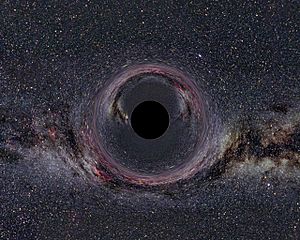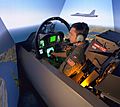Simulation facts for kids
A simulation is like a practice run or a pretend version of something real. It helps us see what might happen without actually doing it. This is useful if something is dangerous, too expensive, or hard to do in real life. Simulations can also show us what happened in the past, what might happen in the future, or what we think is happening in places we can't easily visit, like deep space.
Simulations are very helpful around the world. They let us control things that are hard to control in real life. We can use smaller versions of objects or systems for testing or practice. For example, astronauts practice in a swimming pool to get ready for outer space. This is much safer than practicing in space itself!
Astronauts also used simulations of the moon before they landed there. They practiced in special rooms that moved like real spaceships to get used to the feeling. Many simulations use computers or television screens. Computers can create a simulation of a spaceship's path to the moon. This helps plan the mission carefully.
Contents
Simulations in Video Games
One popular type of video game is called a simulator game. These games let players pretend to do different things. For example, in the game Theme Hospital, players act like doctors and perform pretend surgery. In SimCity, players get to design and build their own pretend city.
How Simulations Help Us
Simulations are used in many different areas to help people learn, train, and plan.
Training and Practice
- Pilots and Drivers: People learning to fly planes or drive trains often use simulators. This lets them practice in a safe place before going into a real vehicle.
- Doctors and Nurses: Medical students can practice operations or emergency procedures on special dummies or computer programs. This helps them learn without putting real patients at risk.
- Soldiers: The military uses simulations to train soldiers for different situations. This can include flying planes, driving vehicles, or practicing combat.
Understanding and Predicting
- Weather Forecasts: Scientists use complex computer simulations to predict the weather. They put in lots of information about the air and oceans to guess what will happen next.
- Building Design: Engineers use simulations to test how strong a bridge or building will be. They can see how it might react to wind or earthquakes before it's even built.
- Science Experiments: Sometimes, experiments are too big, too small, or too dangerous to do in real life. Scientists can use simulations to see what might happen in these cases. For example, they can simulate how planets move or how tiny atoms behave.
Designing and Testing
- Car Safety: Car companies use simulations to crash-test new car designs on computers. This helps them make cars safer without destroying many real cars.
- New Products: Before making a new phone or gadget, companies can simulate how it will work. This helps them fix problems early on.
Images for kids
-
Human-in-the-loop simulation of outer space
-
Motorcycle simulator of Bienal do Automóvel exhibition, in Belo Horizonte, Brazil.
-
3DiTeams learner is percussing the patient's chest in virtual field hospital
-
Firing Room 1 configured for Space Shuttle launches
See also
 In Spanish: Simulación para niños
In Spanish: Simulación para niños













